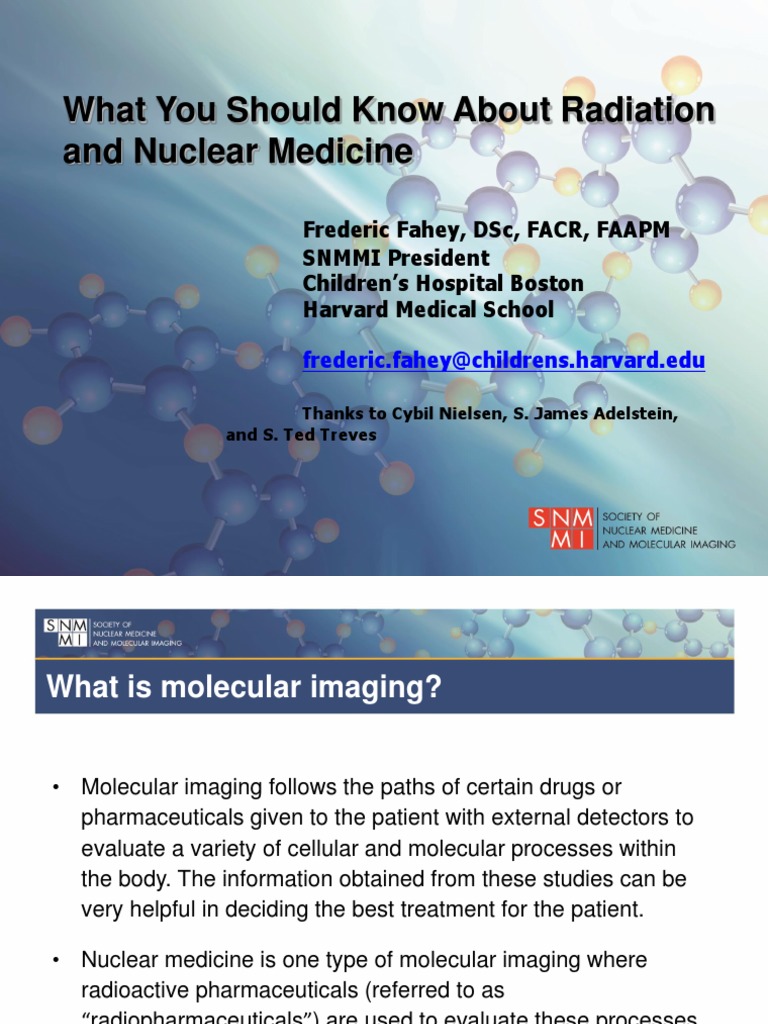The utilization of radiation in nuclear medicine exemplifies a fascinating intersection between advanced physics and clinical healthcare, raising a thought-provoking question: how does one harness the inherent powers of radiation in a manner that fosters human health rather than endangers it? As we delve into this topic, it is vital to navigate the complex landscape of this dynamic field, particularly considering the benefits, challenges, and ethical implications of using radiation in diagnostics and therapeutics.
Nuclear medicine is characterized by the application of radioactive substances for diagnostic and therapeutic purposes. The role of radiation within this specialty cannot be overstated, as it enables healthcare providers to visualize bodily functions and treat various conditions at the molecular level. This capability arises from the unique properties of radioactive isotopes, which emit radiation detectable by specialized equipment. Such isotopes, often referred to as radiopharmaceuticals, are critical for both imaging and therapeutic interventions.
Primarily, radiation in nuclear medicine serves two key roles: diagnosis and therapy. In diagnostic nuclear medicine, nuclear imaging techniques such as positron emission tomography (PET) and single-photon emission computed tomography (SPECT) have revolutionized the way clinicians visualize physiological processes. These methodologies allow for the non-invasive exploration of metabolic activities in tissues and organs, facilitating early detection of pathologies like cancer and cardiovascular diseases.
The fundamental principle behind these imaging techniques hinges on the detection of gamma rays emitted from radiotracers introduced into the patient’s body. These radiotracers, which typically comprise a radioactive isotope bound to a pharmaceutical compound, localize in specific tissues based on metabolic activity. For instance, in oncology, fluorine-18 fluorodeoxyglucose (FDG) is widely utilized to identify malignant cells that exhibit heightened glucose uptake, underscoring the biochemical hallmark of cancerous activity. The resulting images provide invaluable insights into tumor characterization and staging, thus guiding therapeutic decisions.
However, the quest for precise imaging is not devoid of challenges. One pressing concern lies in the potential risks associated with radiation exposure. While nuclear medicine procedures are designed to minimize radiation dosage, the delicate balance between maximizing diagnostic efficacy and ensuring patient safety is a constant consideration. Clinicians must remain vigilant, particularly when addressing vulnerable populations such as children and pregnant women, for whom the repercussions of radiation are often unpredictable.
Transitioning from diagnostics to therapeutic applications, radiation in nuclear medicine manifests uniquely in targeted therapy approaches, most notably through radiotherapy and radioisotope therapy. Radioactive isotopes can be employed to administer treatment directly to diseased cells while sparing nearby healthy tissue. This modality harnesses the principles of targeted radionuclide therapy, where specific isotopes are guided by biological vectors to ensure localized effects, thereby maximizing therapeutic benefits while minimizing side effects.
One of the pioneering examples of therapeutic applications in nuclear medicine is the use of iodine-131 for treating hyperthyroidism and thyroid cancer. Iodine-131’s affinity for thyroid tissue and its radioactive properties allow it to effectively ablate overactive cells or malignant growths. Despite its efficacy, the ethical ramifications of utilizing radiation for treatment must be meticulously examined, raising questions about consent, long-term effects, and the patient’s quality of life post-treatment.
As the field of nuclear medicine continues to evolve, the integration of novel radionuclides and biomolecular engineering offers promising avenues for enhancing patient outcomes. Advanced techniques such as theranostics underscore a personalized medicine approach, whereby diagnostic imaging and therapeutic strategies are cohesively integrated through the use of the same radiopharmaceutical. This development emphasizes the potential for tailored treatments based on individual patient profiles and tumor characteristics, epitomizing a paradigm shift towards precision medicine.
Nevertheless, these advancements are accompanied by multifaceted challenges that necessitate ongoing research and regulatory oversight. The production of radiopharmaceuticals requires meticulous controls to ensure quality, safety, and efficacy. Additionally, the logistics of managing radioactive waste and maintaining environmental safety present substantial hurdles. Furthermore, the accessibility of these innovative therapies remains uneven across healthcare systems globally, thus exacerbating health disparities.
In summary, the role of radiation in nuclear medicine is pivotal, underpinning both diagnostic and therapeutic realms. The transformative capacity of radiation allows for unprecedented insights into human physiology, enabling early detection and intervention. However, with such capabilities come significant responsibilities. Healthcare providers must navigate the intricate balance between harnessing the benefits of radiation and mitigating associated risks, all while considering the ethical implications on patient autonomy and care.
As practitioners grapple with these complexities, the challenge persists: how can the medical community continue to refine the application of radiation in nuclear medicine to enhance patient care while ensuring safety and equity? The answer may lie in fostering interdisciplinary collaborations that bridge the gaps between clinical practice, regulatory frameworks, and technological innovation, ultimately paving the way for a future where the benefits of nuclear medicine are universally accessible and ethically grounded.












